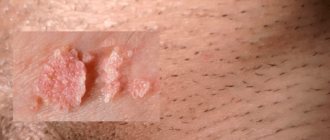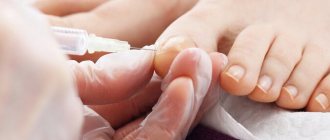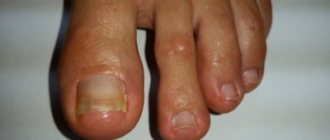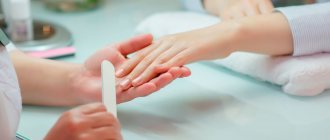Long, graceful, neatly shaped nails are the dream of many women. And often it is quickly and easily performed using an extension procedure.
But no one has canceled the natural growth of nails, so after 3-4 weeks any artificial coverings must be removed. Of course, it is best to do this with the caring hands of a master, while enjoying the cozy atmosphere of a beauty salon.
However, if you need to remove extended nails yourself at home, we will tell you how to do it correctly.
First, determine the material the master used: acrylic or gel. After that, make sure you have all the necessary tools and tools and begin the process.
ruNail, File for artificial nails, gray, semicircular, 150/180
Professional file for artificial nails with two working sides, each of which has abrasiveness.
(47)
33 rub.
33 RUR Buy
TNL, Acrylic and tip remover, 500 ml
A liquid that allows you to remove acrylic and artificial nails without unnecessary filing.
(5)
RUR 394
We'll order soon
Methods for removing nails at home
A fingernail or toenail affected by a fungal infection must be removed. The operation to remove the nail should be carried out in a clinic, using sterile instruments or specialized devices.
There are home methods, but they are all risky due to the high risk of re-infection. How to remove a nail affected by fungus - a detailed description of home techniques is presented below.
Soda baths
Baking soda creates an alkaline environment in which mushrooms cannot survive. Additionally, soda baths soften the affected tissue, facilitating the removal process. How to use baking soda to achieve your goal?
- Steam 1.5 tablespoons of soda with a liter of boiling water.
- Dilute the solution with 2 liters of cold water.
- Use the bath mixture for 10-15 minutes.
- After softening, use manicure tools to remove the softened top layer of the nail plate.
The procedure should be repeated every 3-4 days until the final result is obtained. After each session, all instruments used must be sterilized.
Tar compress
Birch tar accelerates tissue regeneration, has antifungal properties and relieves inflammation. A natural remedy is also used to remove nail plates destroyed by fungus.
Step-by-step instructions for use:
- Steam your fingers in a warm bath with tea tree oil.
- Wipe the surface dry.
- Apply tar heated to room temperature to the affected nail and hole.
- Cover with cling film.
The procedure is performed before bedtime. During the night, the active components of the tar will eliminate inflammation and soften the plate. The remaining tar should be washed off, and then the peeled part of the plate should be removed with a file.
Vinegar
Vinegar creates an acidic environment, thereby regulating the acid-base balance in the area of application. Acetic acid, even in low concentrations, destroys fungal infections and softens the damaged area.
- Concentrated vinegar essence is applied with a cotton swab to the affected area every 2-3 hours. Within a week it will soften and can be easily removed using manicure tools.
- The medicine is prepared from 100 ml of table vinegar and 1 raw egg. The mixture should be rubbed into the nail hole and plate every 2-3 hours for 5-7 days. After the course of treatment, the loose area can be easily removed using a file with large abrasive particles.
“It is unsafe to use acid after a bruise, in the presence of abrasions and cracks in the skin. It is not recommended to use vinegar for warm baths. Acetic acid evaporates quickly, and inhaling its vapors is harmful.”
Spurge
To treat the fungus and remove the affected dead layer, use a strong infusion or decoction of milkweed. How to remove fingernail or toenail using this plant.
- Boil 100 grams of dry plant material in 0.5 liters of boiling water (euphorbia is sold at the pharmacy).
- Let the broth brew for 2 hours.
- Strain and dilute with warm water for a bath.
After a half-hour bath, it is necessary to cut off the loose layer and disinfect the treated area. This method is popular and almost every thematic forum contains information about it. People's reviews are mixed, so you shouldn't count on the maximum effect.
Recommendations during the recovery period
The effectiveness of the treatment largely depends on the patient’s behavior during the rehabilitation period. Our experts give the following recommendations during the recovery period:
- be careful not to allow the correction plates to come off and the staples to be lost;
- temporarily stop wearing nail polish;
- Use orthoses to prevent calluses while wearing braces.
For 5-6 days after laser surgery, it is necessary to change the bandage twice a day, treat the plate and side rollers with an antiseptic, and re-bandage the finger. On the 7th day, the bandage can be removed - this will speed up the process of tissue restoration. The patient should not visit saunas, steam baths, or swimming pools for a week.
Pharmacy products for removing the nail plate
In addition to folk remedies, there are also pharmaceutical preparations for removing the nail plate. The dead layer is removed using:
- antifungal patches;
- ointments;
- varnishes;
- tablets.
Examples and methods of using nail remover preparations are presented in the table:
| Product type | Name | Mode of application | Result |
| Patch | Onychoplast. Ureaplast. | Steam your fingers in a soap and soda bath. After softening, cut off the loose part, disinfect and seal with adhesive tape. The exposure time is indicated in the instructions and is different for each type. | Elimination of fungal infection, painless removal of the affected nail plate. |
| Ointment | Mikospor. Loceril. | The ointment is applied after a warm bath under the dressing. After -5 hours, the remaining product is washed off, and the plate is sanded using a file. | Softening the nail plate, treating fungal infections, eliminating inflammation. |
| Pills | Metronidazole. Nystatin. | Grind into powder, dilute with water for injection to obtain a thick paste. Apply at night under a bandage. | Elimination of infection and loosening of the nail plate for further removal. |
It is recommended to discuss drug treatment for fungus with your doctor. If you use the wrong drug, treatment will not give results, but will only worsen the situation.
Care after removal
After removing a nail, the risk of recurrence and bacterial infection increases. To prevent the disease from returning, it is necessary to follow simple rules for wound care and prevention.
- Treat the wound with an antiseptic 3-4 times a day and apply antibacterial ointment.
- Until complete healing, wear a bandage or cover the wound with a plaster.
- Minimize the load on the finger, avoid tight shoes.
- Avoid visiting public baths, swimming pools, and showers.
- Avoid overheating and hypothermia.
- Follow the principles of a healthy, balanced diet.
- To refuse from bad habits.
If your body temperature rises or additional unpleasant symptoms appear, you should immediately seek help from a hospital. Such phenomena indicate the onset of an abscess. Inaction in such situations is fraught with the development of gangrenous processes, which often lead to the need for emergency amputation of the finger.
Conclusion
Experts do not recommend carrying out such procedures at home due to the increased risk of complications. Traditional medicine offers dozens of methods for treating fungal infections, so it is advisable to consult a doctor in a timely manner. This will save not only your health, but also your time.
Methods for removing a diseased nail
Basic methods for removing nails affected by fungus
The procedure for removing the affected nail involves not only mechanical removal of the nail plate, but also subsequent treatment. It is important to take precautions to prevent the infection from spreading to other fingers. There are several ways to remove a nail:
- surgical;
- carry out a hardware procedure;
- medications;
- folk remedies.
Each option has disadvantages and advantages that you need to be aware of before starting treatment.
Diagnosis of the disease
Surgeons and podologists treat ingrown toenails. To make a diagnosis, the doctor examines the foot. If he deems it necessary, the patient may be prescribed:
- OAM;
- UAC;
- x-ray of the foot (indicated if the doctor suspects osteomyelitis, osteophyte);
- bacteriological examination (necessary if an ingrown toenail is accompanied by suppuration, to determine the microorganisms that caused the disease and their sensitivity to antibacterial drugs).
Based on the diagnostic results, the doctor decides how to remove the ingrown toenail.
Surgical method for removing a diseased nail
The most unpleasant way to remove a diseased nail, but what can you do when the situation is critical and the form is completely neglected. We'll have to be patient.
The surgery, in which the entire toenail is removed, is performed under local anesthesia. This method of getting rid of onychomycosis is now rarely used, since it has many disadvantages:
- insignificant effectiveness (getting rid of the fungus occurs in one case out of five);
- high surgical traumatism;
- a long period of rehabilitation with limited mobility - the patient is forced to remain in bed for some time, and he will have to undergo daily painful treatments of the operated area and dressings;
- there is a high risk of infection in an open wound;
- the new nail often grows out deformed.
Surgical removal is important for advanced stages of onychomycosis.
Hardware method
Many people like hardware pedicure because it feels like cutting your nails.
Using this method, you can get rid of damaged horny plates on the nail quickly and almost painlessly. In most cases, one session is enough to relieve the patient of an unpleasant illness. The procedure is performed exclusively in a medical facility under highly sterile conditions using a special apparatus.
The essence of the method is layer-by-layer removal of infected layers down to the soft tissue of the bed. This ensures rapid and deep penetration of antifungal agents into the nail. Before starting the procedure, the nail is disinfected, and then it is softened with special preparations. The removal itself is carried out using nozzles with diamond tips and metal cutters.
Hardware pedicure has a number of advantages over the surgical method:
- painlessness;
- the treatment period is reduced by 2 times;
- there is no major bleeding of the treated area;
- restored nails do not lose their aesthetic appeal.
Now it is possible to purchase machines with attachments for hardware pedicure and perform the procedure yourself. However, illiterate actions and failure to comply with sterility rules can aggravate the situation and lead to serious complications.
Hardware pedicure is not recommended for pregnant women, allergy sufferers, patients suffering from kidney or liver diseases, or those with dermatological pathologies.
Removal of a nail with onychomycosis using medications
Nowadays, there are a huge variety of medications that can be used to make the nail come off from its bed without surgical intervention. These are all kinds of plasters, solutions, folk remedies.
At home, you can remove damaged nails with special preparations sold in pharmacies. They are worthy competition to hardware and surgical removal methods. Their action is aimed at preliminary softening of the plate and its subsequent removal. The composition of the products determines the frequency of application, its method, as well as contraindications. Modern drugs contain substances that not only help soften the nail, but also actively act on fungal infections. The drugs “Nogtimitsin” and “Nogtevit” have gained a good reputation. They contain stearic acid and a natural antiseptic - tea tree oil.
Technology for removing nails damaged by onychomycosis using “Nogtevit”:
1. Steam the damaged areas in hot water with the addition of liquid soap and soda (1 tsp per liter of water). Wipe your fingers dry.
2. Carefully treat infected nails with the drug, without affecting the area of healthy tissue.
3. Cover your nails with a bandage and leave the bandage on for 4 days.
4.Remove the patch, steam your nails, and carefully scrape off any loose particles with a wooden manicure stick.
5. Repeated manipulations should be carried out until the nail is completely removed.
The required number of nail removal procedures depends on its thickness and the degree of infection penetration into the plate. One jar is enough to remove 3-4 nails.
Among other medications, the keratolytic patch deserves attention. The principle of its action is similar to ointment preparations. The patch is applied for 3 days. During this time, the active substances soften the nail and destroy the infection. Secure the treatment bandage with a regular plaster.
You can also soften the nail for subsequent removal with special varnishes, but during this period it is important that the damaged area does not come into contact with water.
When the nail plate becomes significantly thinner under the influence of medications, you should begin daily treatment of the surface with tea tree oil.
Materials and tools for removing gel polish using the soaking method
To soak gel polish with a special liquid, we will need:
- a rough file, the abrasiveness of which is approximately 100 grit;
- cotton pads;
- scissors for cutting cotton pads;
- gel polish remover;
- aluminum foil (you can use food grade foil instead of professional grade);
- orange stick or metal pusher;
- buff;
- file for natural nails;
- cuticle oil and hand cream (if you do not plan to apply a new gel polish coating immediately or on the same day);
- paper towel or napkins.
Nail file classic pink 100/180 g ParisNail
Gel polish remover E.MiLac Remover 1000 ml
Orange sticks small IRISK 90-100 pcs
Pusher for manicure P-09 wide spatula/peak length 132 mm Nippon Nippers
Buff mini 100/180 white ParisNail 50 pcs
Disposable files 220/280 11.5 cm (05 Turquoise) IRISK 10 pcs/pack
Two-phase cuticle oil strengthening Apple Vogue Nails 10 ml
Nourishing hand cream “Delicious hands” Blackcurrant IRISK 250 ml
Instead of liquid, you can use special napkins for soaking gel polish.
In this case we will need:
- rough nail file;
- gel polish remover wipes;
- orange stick or metal pusher;
- buff;
- file for natural nails;
- cuticle oil and hand cream (if you do not plan to re-coat);
- paper towel or napkins.
Straight file black UT-401 A 100-180 ZINGER
Wipes for removing gel polish, polish in individual packaging InGarden 200 pcs
Orange sticks medium IRISK 8 pcs
Buff mini 100/180 black ParisNail 50 pcs
Disposable files 220/280 11.5 cm (06 Purple) IRISK 10 pcs/pack
Cuticle oil “Jasmine” in pencil ruNail
Hand cream Cream Oil with grape seed oil and jojoba ARAVIA 550 ml
Folk remedies for removing nails affected by fungus
Traditional medicine will always occupy a strong position in the home medicine cabinet, the main thing is that these remedies are proven and safe!
The use of folk remedies does not provide a quick effect and guarantee complete relief from fungal infection. Moreover, their use can cause allergies, aggravation of the disease, infection, and the new nail may grow crooked.
The effect of folk remedies is to soften the stratum corneum. The products are applied to steamed nails, and after some time the diseased layer is removed using manicure accessories. The most popular and safe folk methods include the following:
Steaming your hands or feet in a very hot baking soda solution (as much as you can tolerate). You can add shavings of laundry soap and a few drops of tea tree oil to the liquid. After steaming, carefully remove the softened nail particles with a disinfected nail file. Treatment does not stop until the nail plate is completely renewed. Procedures should be done every 1-3 days.
- Egg ointment, 1 tsp. vegetable oil and 1 tsp. dimethyl phthalate. Apply the prepared mixture to the damaged area, previously steamed in hot water, cover the nail with film, wrap it in cotton cloth, insulate it and leave for several hours. Then the softened layer of the nail is removed. It is optimal to perform this procedure before bedtime.
- Birch tar. The disinfectant properties of this folk remedy successfully help defeat fungal infections. Freshly prepared tar is most effective. It can be obtained as follows. A bucket with holes in the bottom is suspended above the ground to a height of 15-30 cm, and a container is placed under it. Birch bark is placed in a bucket and set on fire. The combustion products flowing out of the holes are healing tar. It is applied to the affected nail at night, covered with cellophane film, and wrapped in a warm cloth. Nails treated with birch tar are disinfected and made soft and pliable to manicure tools.
Remember! Removing the nail for onychomycosis is a last resort. This procedure is prescribed when the process of rapid destruction of the stratum corneum has begun. Treatment started in the early stages of the disease will avoid troublesome and unpleasant nail removal procedures.
How to tear off a nail without pain. How to smear a torn nail: treatment tips
Damage to the fingers and toes requires a visit to the clinic if there are suspicious symptoms, but in some cases, caring for the nail plates can be done at home. How to smear a torn nail and is it possible to combine drugs?
Ointment for torn nails is sold at any pharmacy. But in order to treat the wound correctly, certain knowledge is required. If the nail bed is damaged and the plate is torn off, it is advisable to consult a doctor immediately. In the hospital emergency room they will provide first aid and this will help to avoid unpleasant consequences.
Is it permissible to treat a finger yourself? If it is not possible to visit a doctor, you can try to disinfect the wound at home. First, rinse the injured finger with clean water. Boiled and cooled water is ideal for these purposes. The presence of dirt or any foreign microparticles in the wound is not allowed. Neglecting this rule can lead to suppuration. If the nail bed is bleeding heavily, it is recommended to moisten it with a solution of hydrogen peroxide. You can apply a tampon soaked in peroxide to this area. Next, you need to treat the wound with any antiseptic that does not contain alcohol. You can use special preparations or wash the wound with a solution of potassium permanganate.
The next step in treating the damaged nail bed should be to apply an ointment containing an antibiotic to the area. For example, you can use “Geoxyzon” or “Levomekol”. These drugs are sold at any pharmacy, but it is better to always have them in your home medicine cabinet, so that in case of injury you can quickly provide first aid to the victim. Antibiotic ointments help prevent inflammation.
In order for the nail bed to heal faster, you need to fix the ointment and prevent the penetration of moisture and contaminants into the wound. For this it is better to use a sterile bandage. It is important that the damaged area is protected with a pad and that particles of the bandage do not stick to the wound. A special sterile patch on a non-woven base is very convenient to use. It protects the wound, but at the same time comes off the skin quite easily. After a day, you should start smearing the nail bed with healing ointment. For example, you can use Solcoseryl.
In what cases should you not neglect to see a doctor? Pulsating or aching pain in the finger and the appearance of pus should alert you. You should immediately consult a surgeon if your finger becomes swollen or red. When the damaged nail peels off by half and turns black, it is also better to visit the emergency room, as removal of the nail plate may be necessary. For a month after the injury, it is recommended to take care of yourself and try not to strain the sore arm or leg. If necessary, you should take sick leave. When your toe is injured, it is advisable to temporarily change your shoes to more comfortable ones. It is important that the nail bed is not squeezed so that blood flow is not impaired.
Unfortunately, this type of injury is not always harmless. If dirt or sand gets into the wound, it is better to consult your doctor and get a tetanus shot immediately. If the treatment is done correctly, a new nail can grow within a couple of months. But during the period of treatment and rehabilitation, do not forget about changing the bandages. It is recommended to bandage the wound every day, and on the fourth day it is better to discard the bandage and provide air access to the nail for its speedy healing.
To cure a torn nail, you need to regularly smear it with a special ointment. Also, one should not forget about maintaining sterility conditions. If your finger is swollen, you should consult a doctor immediately, as self-medication can be dangerous.
How to remove a diseased nail
Sometimes, if there is no effect from conservative therapy to cure the disease, doctors have to resort to a drastic method, which includes removing the nail plate and removing the nail on the finger or toe. Many patients are afraid of this procedure, thinking that removing a toenail due to a fungus or other disease is an extremely painful operation, after which a long period of rehabilitation will be required. To know how to behave in the postoperative period, you need to understand why you need to remove the nail, what surgical methods are used for this.
Pull out the nail. Will a torn nail grow back: nail regeneration
Most often, nails “peel off” on their own due to mechanical trauma in the form of pinching, cutting or severe bruising, when a hematoma forms under the plate, completely blocking its nutrition, as a result of which the nail simply dies.
In this case, the answer to the question of whether the torn nail will grow back will directly depend on one key factor - whether there has been damage to the matrix, which means the nail root responsible for the growth of the plate. And if the matrix, hiding under the lower periungual ridge, remains unaffected, then the likelihood that the nail will completely recover over time is very high, amounting to, if not 100, then all 99 percent, however, this feature should not be taken into account when thinking about whether it will grow or a torn nail, because this is impossible under any circumstances.
The fact is that the root is capable of generating new cells and usually successfully copes with this function after receiving various types of injuries, but it is almost impossible to restore nutrition to an already torn plate, therefore, even if it is still held on the finger due to its tight fit in the nail bed area , doctors still recommend removing it for a number of reasons. And above all, they refer to constant discomfort and acute pain, which is felt with any awkward movement.
If the matrix part is damaged or its forced resection, the chances of successful restoration of the nail are zero and in rare cases the plate can be partially restored, however, its updated appearance can hardly be called aesthetic. Sometimes partial resection of the matrix (as a rule, we are talking about removing its lateral part) is indicated due to the structural features of the nail plate, which digs into the periungual ridges, provoking an inflammatory process and decay.
In this case, the side of the nail is removed along with the matrix, as a result of which the area of the plate is reduced and does not cause such complications. Meanwhile, long-term purulent inflammation can provoke complete loss of the nail plate, and this situation is well known to many people suffering from type 1 and type 2 diabetes mellitus. In this case, it is extremely important to prevent such a development of the situation by following a certain low-gluten diet and completely abandoning bad habits, since such complications can be irreversible, which is what most often happens.
Unfortunately, complete or partial loss of a nail can also be caused by a common fungus, the presence and development of which the patient may not be aware of for a long period of time. However, any change in the color of the nail, its thickening or deformation, as well as the formation of cracks and transverse/longitudinal stripes should be regarded as the first signs of mycotic lesions.
Blackening of the nail bed without bruising or pinching also indicates that a fungus has long developed in the area of the nail plate and further ignoring the problem can lead to its complete loss. As for the process of nail restoration, its full regeneration is possible only after successful treatment of mycosis. It should be remembered that in winter nails grow slower than in summer, fingernails grow faster than toenails, and factors such as age and gender are also of great importance in this matter.
Thus, in women and young people under 20 years of age, the nail plate recovers much faster. In addition, nails growing on the fingers of the working hand have a greater chance of full recovery, since blood circulation is more developed in this limb. Alternatively, you can accelerate the growth of the damaged plate with the help of special hormonal drugs, but only after consultation with a dermatologist.
Reasons for nail removal
Not only the nail itself can be removed, but also the nail bed, consisting of connective tissue. Many ailments affect the health of the nails, leading them to such a state that conservative treatment methods no longer work. The causative agents of the disease are located on the nail bed, and it is impossible to get to them otherwise. The list of diseases that may require removal of the nail plate is extensive. These include:
- onychomycosis of the nail, or fungus;
- psoriasis, eczema, lichen;
- diabetes;
- herpes;
- ingrowth of the horny plate into tissue ridges;
- injury;
- squamous or basal cell carcinoma.
For fungus
Onychomycosis is a common disease that affects the entire nail plate. As the fungal infection spreads, the plate changes color, shape, and can become bent or significantly deformed, significantly complicating everyday life. Conventional means used to combat fungus may not help, since the spores of the parasite are located on the nail matrix and bed, which is almost impossible to influence from the outside. In such cases, doctors recommend removing the nail to get rid of the mycotic lesion.
When ingrown
Every tenth person develops onychocryptosis during their lifetime. The nail plate is surrounded by ridges of skin that hold it in place. Sometimes the nail begins to grow incorrectly, the person experiences severe pain, the skin around the nail swells, turns red, and an infection begins. At advanced stages of ingrowth, correction of the ingrown plate is impossible; its elimination is required. If the nail is located on the toe, then walking becomes painful. For ingrown toenails, dermatologists recommend removing the plate to avoid the spread of inflammation.
In case of injury
Many injuries and defects of the hands or feet affect the condition of the nails - deformation of the nail plate occurs, and pathogenic bacteria enter the wound, causing infection. At the injured site, suppuration and redness appear, and the inflammatory process begins. The finger swells and festeres. In such a situation, immediate removal of the nail with parallel measures to eliminate inflammation is required.
Why do nails grow ingrown?
The most common cause of the disease is improper pedicure technique. The nail grows into the skin if you use scissors with rounded edges and cut off its corners.
The second most common cause is a fungus (onychomycosis). It leads to delamination of the plate, so it becomes brittle and can bend and “cut” into the roller.
Other causes of ingrowth may be:
- pressing shoes, narrowed toes of shoes, boots;
- hereditary predisposition;
- blow, bruised finger.
These are key factors in the disease, but not the only ones. Inflammation of an ingrown toenail can also develop with flat feet, diabetes, and obesity.
Nail removal methods
Surgical removal as the only possible method of plate resection is a thing of the past. There are many modern effective medicinal methods that help get rid of the affected nail with minimal pain for the patient and with a high probability of no recurrence of the disease in the future. There are several such methods:
- hardware method;
- radio wave method;
- laser removal;
- chemical treatment;
- mechanical removal.
Laser method
Laser treatment of the affected surface is a good remedy for removing nail fungus. The required temperature is set on the instrument, and using a laser beam with a diameter of less than a millimeter, complete or partial removal of the affected surface occurs. At the same time, pathogenic fungi on the nail bed are destroyed. The advantages of the laser method include:
- excellent effect, since the pathogens of mycosis are completely destroyed;
- gentle effect on the affected area - intact (undamaged) skin is not affected;
- minimal possibility of relapse.
Surgical method
Many doctors recommend surgery to completely remove the affected plate as the best option for advanced disease. The operation is performed on an outpatient or inpatient basis with preliminary local anesthesia. The doctor uses a scalpel to separate the nail from the bed and remove it, after which he treats the wound with an antibiotic, and the patient can go home. A contraindication to this radical method is impaired vascular permeability of the extremities and a low rate of regeneration of damaged tissue.
Chemical removal
This procedure is almost completely painless and consists of the following steps:
- A special tape is applied to the intact skin around the nail to avoid the possibility of damage.
- An ointment to remove nail fungus containing special chemicals is applied to the affected surface.
- The bandage is securely fixed and cannot be wetted.
- After 3-4 days, the nail, under the influence of the ointment, softens and is carefully removed.
Radio wave method
Removal of the plate using radio waves is performed on an outpatient basis, using local anesthetics. Using a special device, the doctor evaporates the affected areas of the plate, after which he applies a sterile bandage. According to reviews, pain is minimal, and the patient returns to normal life the very next day.
Fungal nail remover
Pharmacies offer many products that help get rid of the infected stratum corneum with minimal pain. If such drugs are used to remove nail fungus at home, on your own, and not under the supervision of a qualified dermatologist, then you must carefully follow the instructions for using these medications. Such drugs include:
- special ointments, creams, emulsions;
- keratolytic patches;
- keratolytic varnishes;
- folk remedies.
There are many pharmacological drugs that help painlessly and quickly get rid of the infected stratum corneum, but removal must occur in strict accordance with the instructions to prevent infection of the wound surface. Reviews of the most popular and common emulsions and ointments that help effectively remove the horny surface are given below.
- Nailitis. It is a thick emulsion containing urea and lactic acid, which help soften the plate. The nail must be prepared by softening it in a hot bath with furatsilin solution, washed and dried. Then apply a thick layer of emulsion, cover with a band-aid and leave for a day. The advantages of using the ointment include a gentle effect on the plate, the disadvantages are the length of time it takes to wait for action, and a possible allergy to the components.
- Nogtimycin. The composition contains fatty acids and oil of lavender and mint. Ointment is applied to the previously prepared stratum corneum, after which the surface is covered with a plaster. After 3-4 days, the bandage is removed, a hot bath is taken to soften the nail plate, after which the keratinization is removed. The advantages of the product include a gentle effect on the surface, the disadvantages are the need to regularly change the dressings.
Patch
Keratolytic patches compare favorably with ointments in their ease of use and low probability of penetration of the active substance onto the intact surface. The most common are the following adhesive masses:
- Onychoplast. A special patch for removing nail fungus based on urea. Rub a pea of the plaster mass between your fingers, apply to a previously prepared surface, apply a bandage, leave for 3-4 days, then carefully remove the keratinization. The advantages include ease of use, the disadvantages are the duration of exposure.
- Ureaplast. The active ingredients are urea and lead plaster. Remove the top layer from the prepared horny plate, apply the product, cover with a bandage, leave for a day, then repeat the procedure until completely softened. The advantages include painless removal, the disadvantages are the duration of wearing the bandage.










